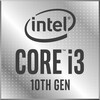Apple A13 Bionic vs Intel Core i3-1000G1
Apple A13 Bionic
► remove from comparison
The Apple A13 Bionic is a System on a Chip (SoC) from Apple that is found in the iPhone 11 series. It was announced late 2019 and offers 6 cores divided in 2 performance cores and four power efficiency cores. Compared to the previous A12 Bionic, the A13 should offer a 20% improved CPU performance at 40% lower power (according to Apple).
With 8.5 billion transistors, the A13 Bionic is a big chip especially compared to the Snapdragon 835 (3 Billion) or a Skylake desktop quad-core Soc (1.75 Billion).
Intel Core i3-1000G1
► remove from comparison
The Intel Core i3-1000G1 is a power efficient dual-core SoC for laptops and Ultrabooks based on the Ice -Lake-U generation that was announced in Mai 2019 (Computex). It integrates two Sunnycove processor cores (4 threads thanks to HyperThreading) clocked at 1.1 (base) - 3.2 GHz (single and dual core Turbo). According to Intel the Sunnycove cores achieve 18% more IPCs (Instructions per Clock).
The biggest improvement for Ice-Lake is the integrated Gen 11 architecture graphics adapter called UHD Graphics G1. The Core i3-1000G1 integrates the smallest GPU, the UHD Graphics that features 32 of the 64 CUs and clocks at 300 - 900 MHz. The faster variants offer higher clock speeds (up to 1100 MHz) and include Iris Plus G4 (e.g. in the similar named Core i3-1000G4) and G7.
Other improvements for Ice Lake are the AI hardware acceleration and the partial integration of Thunderbolt and WiFi 6 in the chip. The integrated DDR4 memory controller supports modules with up to 3200 MHz (and LPDDDR4 3733).
Performance
We have not tested a single system built around the 1000G1 as of August 2023. Expect the chip to be at least as fast as the Pentium 6500Y (two Amber Lakes cores, 4 threads, up to 3.4 GHz). In other words, not fast at all.
Power consumption
This Core i3 has a default TDP (also known as the long-term power limit) of 9 W, a value that laptop manufacturers are allowed to reduce just slightly to 8 W resulting in lower clock speeds and lower performance. TDP values that low are typical for affordable laptops, tablets and mini-PCs, mostly with no active cooling solution.
The processor is built with Intel's 2nd generation 10 nm process for decent, as of late 2022, energy efficiency.
| Model | Apple A13 Bionic | Intel Core i3-1000G1 | ||||||||||||||||
| Codename | Lightning and Thunder | Ice Lake-Y | ||||||||||||||||
| Series | Apple Apple A-Series | Intel Ice Lake | ||||||||||||||||
| Clock | <=2660 MHz | 1100 - 3200 MHz | ||||||||||||||||
| L1 Cache | 832 KB | |||||||||||||||||
| L2 Cache | 12 MB | 1 MB | ||||||||||||||||
| Cores / Threads | 6 / 6 | 2 / 4 | ||||||||||||||||
| Transistors | 6900 Million | |||||||||||||||||
| Technology | 7 nm | 10 nm | ||||||||||||||||
| Features | ARMv8 Instruction Set | LPDDR4-3733 RAM, PCIe 3, 4 GT/s bus, DL Boost, GNA, MMX, SSE, SSE2, SSE3, SSSE3, SSE4.1, SSE4.2, AVX, AVX2, AVX-512, BMI2, ABM, FMA, ADX, VMX, SMEP, SMAP, EIST, TM1, TM2, HT, Turbo, SST, AES-NI, RDRAND, RDSEED, SHA, SGX | ||||||||||||||||
| iGPU | Apple A13 Bionic GPU | Intel UHD Graphics G1 (Ice Lake 32 EU) (300 - 900 MHz) | ||||||||||||||||
| Architecture | ARM | x86 | ||||||||||||||||
| Announced | ||||||||||||||||||
| Series: Ice Lake Ice Lake-Y |
| |||||||||||||||||
| L3 Cache | 4 MB | |||||||||||||||||
| TDP | 9 Watt | |||||||||||||||||
| max. Temp. | 100 °C | |||||||||||||||||
| Manufacturer | ark.intel.com |
Benchmarks
Average Benchmarks Apple A13 Bionic → 0% n=0
* Smaller numbers mean a higher performance
1 This benchmark is not used for the average calculation












